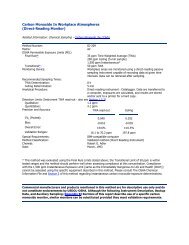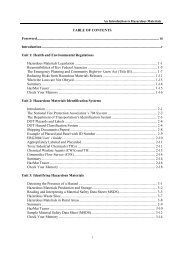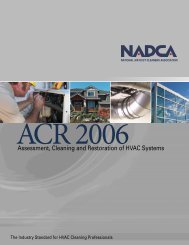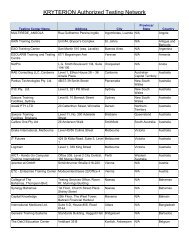Dampness and Mould - WHO guidelines for indoor air quality - PRWeb
Dampness and Mould - WHO guidelines for indoor air quality - PRWeb
Dampness and Mould - WHO guidelines for indoor air quality - PRWeb
You also want an ePaper? Increase the reach of your titles
YUMPU automatically turns print PDFs into web optimized ePapers that Google loves.
31<br />
3. Moisture control <strong>and</strong> ventilation<br />
Olli Seppänen <strong>and</strong> Jarek Kurnitski<br />
3.1 Introduction<br />
Buildings provide shelter from climate <strong>for</strong> their occupants. Local resources, culture,<br />
climate <strong>and</strong> building traditions have significant effects on building design<br />
<strong>and</strong> construction. Since buildings have long lifetimes <strong>and</strong> use a significant portion<br />
of national assets, the construction industry is regulated by international or<br />
national codes <strong>and</strong> <strong>guidelines</strong>. Building codes are usually intended to ensure the<br />
<strong>quality</strong> of buildings: their safety <strong>and</strong> health properties <strong>and</strong> also the sustainable<br />
use of natural resources, such as energy, to reduce the environmental impact of<br />
the built environment. With increasing scientific underst<strong>and</strong>ing of the problems<br />
represented by moisture <strong>and</strong> dampness <strong>and</strong> recognition of the widespread nature<br />
of these problems, all countries must pay proper attention to how the <strong>quality</strong> of<br />
construction affects these problems. As construction practices vary among countries,<br />
it is difficult to create <strong>guidelines</strong> that are applicable in all regions. Nevertheless,<br />
many problems have the same origin <strong>and</strong> their solutions are thus similar in<br />
principle. The purpose of this chapter is to characterize the sources of <strong>and</strong> solutions<br />
<strong>for</strong> moisture <strong>and</strong> dampness problems in buildings <strong>and</strong> discuss the role of<br />
ventilation in controlling moisture <strong>and</strong> providing a healthy <strong>indoor</strong> environment.<br />
Ventilation is intended to remove or dilute pollutants <strong>and</strong> to control the thermal<br />
environment <strong>and</strong> humidity in buildings. It must be sufficient either to remove<br />
pollutants <strong>and</strong> humidity generated <strong>indoor</strong>s or to dilute their concentrations<br />
to acceptable levels <strong>for</strong> the health <strong>and</strong> com<strong>for</strong>t of the occupants <strong>and</strong> must be<br />
sufficient to maintain the building’s integrity. A number of reviews (Seppänen,<br />
Fisk, Mendell, 1999; Wargocki et al., 2002, Sundell, Levin, 2007) have shown an<br />
association between ventilation <strong>and</strong> health, although the precise exposure–response<br />
relationship differs by study. As exact values <strong>for</strong> ventilation cannot be<br />
identified <strong>and</strong> limit values have not been set <strong>for</strong> all pollutants, it is seldom possible<br />
to determine the necessary ventilation rates <strong>and</strong> the associated risks on the<br />
basis of pollutant concentrations. Selection of ventilation rates is based on epidemiological<br />
research, laboratory <strong>and</strong> field experiments, odour perception, irritation,<br />
occupant preferences, productivity, <strong>and</strong> experience.<br />
Ventilation can be provided by various natural <strong>and</strong> mechanical methods.<br />
These usually improve health but may also have adverse effects (Seppänen, Fisk,<br />
2002; Wargocki et al., 2002) if not properly designed, installed, maintained <strong>and</strong>






